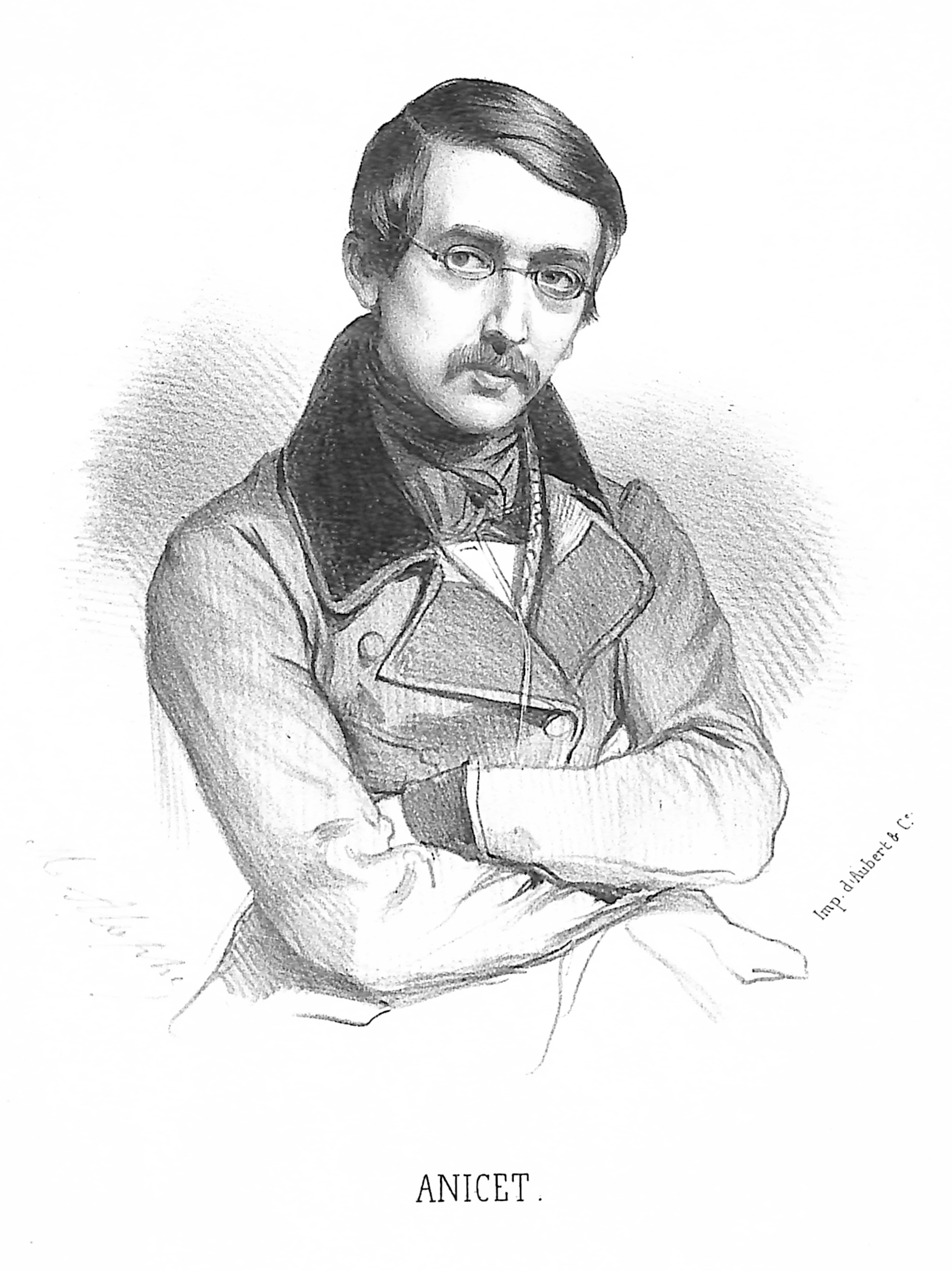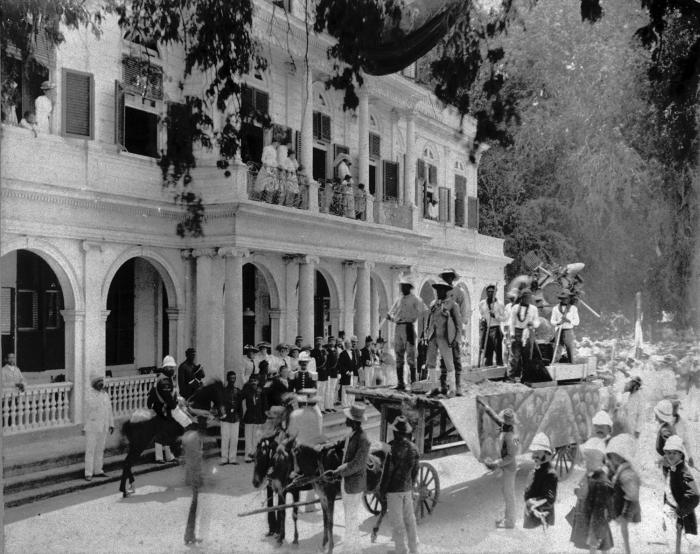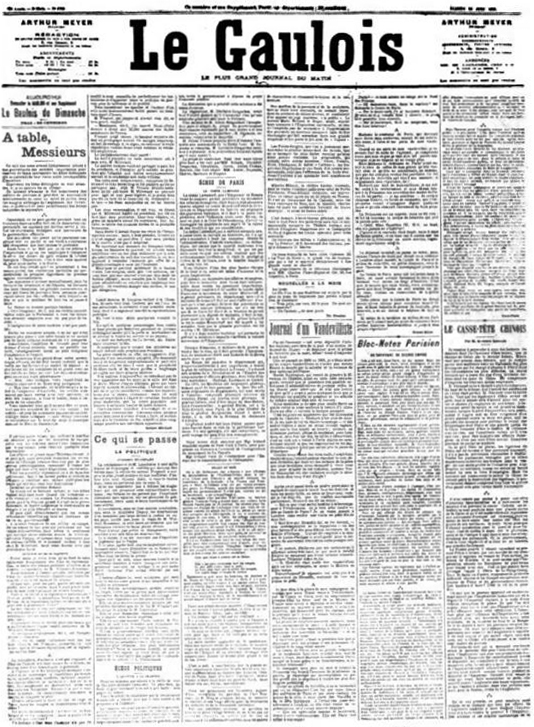|
Ferdinand Dugué
Ferdinand Dugué (18 February 1816 – 5 December 1913) was a 19th-century French poetry, French poet and playwright. He wrote poetry and both comic and dramatic plays, some of them in collaboration. He also authored studies about historic personalities such as Mathurin Régnier and Salvator Rosa. Biography Family Dugué was born in Chartres, the son of Pierre-Joseph Dugué de La Fauconnerie, a lawyer, and Barbe Victoire Thérèse Feron. On 20 November 1840, he married Henriette Joséphine Béguin, daughter of a naval officer, with whom he would celebrate their 70th anniversary of marriage in 1910. The bridal blessing took place in the chapel of the Paris Foreign Missions Society, rue du Bac. The politician Henri-Joseph Dugué de La Fauconnerie was his nephew. Youth He grew up in a house in the cloister Notre-Dame à Chartres. After attending college in that city, he continued his studies in Paris, hosted by the Pension Landry, where he earned a mention at the Concours g ... [...More Info...] [...Related Items...] OR: [Wikipedia] [Google] [Baidu] |
Chartres
Chartres () is the prefecture of the Eure-et-Loir department in the Centre-Val de Loire region in France. It is located about southwest of Paris. At the 2019 census, there were 170,763 inhabitants in the metropolitan area of Chartres (as defined by the INSEE), 38,534 of whom lived in the city (commune) of Chartres proper. Chartres is famous worldwide for its cathedral. Mostly constructed between 1193 and 1250, this Gothic cathedral is in an exceptional state of preservation. The majority of the original stained glass windows survive intact, while the architecture has seen only minor changes since the early 13th century. Part of the old town, including most of the library associated with the School of Chartres, was destroyed by Allies of World War II, Allied bombs in 1944. History Chartres was one of the principal towns in Gaul of the Carnutes, a Celts, Celtic tribe. In the Gallo-Roman period, it was called ''Autricum'', name derived from the river ''Autura'' (Eure), and a ... [...More Info...] [...Related Items...] OR: [Wikipedia] [Google] [Baidu] |
World War II
World War II or the Second World War, often abbreviated as WWII or WW2, was a world war that lasted from 1939 to 1945. It involved the vast majority of the world's countries—including all of the great powers—forming two opposing military alliances: the Allies and the Axis powers. World War II was a total war that directly involved more than 100 million personnel from more than 30 countries. The major participants in the war threw their entire economic, industrial, and scientific capabilities behind the war effort, blurring the distinction between civilian and military resources. Aircraft played a major role in the conflict, enabling the strategic bombing of population centres and deploying the only two nuclear weapons ever used in war. World War II was by far the deadliest conflict in human history; it resulted in 70 to 85 million fatalities, mostly among civilians. Tens of millions died due to genocides (including the Holocaust), starvation, ma ... [...More Info...] [...Related Items...] OR: [Wikipedia] [Google] [Baidu] |
Pierre Larousse
Pierre Athanase Larousse (23 October 18173 January 1875) was a French grammarian, lexicographer and encyclopaedist. He published many of the outstanding educational and reference works of 19th-century France, including the 15-volume ''Grand dictionnaire universel du XIXe siècle''. Early life Pierre Larousse was born in Toucy, where his father was a blacksmith. At the age of sixteen he won a scholarship at the teaching school in Versailles. Four years later, he returned to Toucy to teach in a primary school, but became frustrated by the archaic and rigid teaching methods. In 1840 he moved to Paris to improve his own education by taking free courses. Career From 1848 to 1851 he taught at a private boarding school, where he met his future wife, Suzanne Caubel (although they did not marry until 1872). Together, in 1849, they published a French language course for children. In 1851 he met Augustin Boyer, another disillusioned ex-teacher, and together they founded the ''Librairie ... [...More Info...] [...Related Items...] OR: [Wikipedia] [Google] [Baidu] |
The Sea Of Ice (play)
''The Sea of Ice'' is a 19th century melodrama play in English adapted from the 1853 French play ''La Priére des Naufragés'' (Prayer of the Wrecked) by Adolphe d'Ennery and Ferdinand Dugué.Holman, Andrew & Robert K. Kristofferson, edsMore of a Man: Diaries of a Scottish Craftsman in Mid-Nineteenth-Century p. 672 n. 70 (2013) French debut The French play under the title ''La Priére des Naufragés'' was first performed at the Théâtre de l'Ambigu-Comique and debuted on 20 October 1853. Original Paris cast *Carlss by Charles de Chilly *Barabas by Laurent *Raoul de Lascours by Delafosse *Georges De Laval by M. Coste *Horace de Brionne by C. Lemaitre *Medoc by Machanette *Un Secretaire d'Ambassade by Depresle *Un Intendant by Martin *Premier Matelot by Richer *Deuxieme Metelot by Lavergne *Louise de Descours by Marie Laurent *Ogarita by Idem *La Comtesse de Theringe by Mesanges *Diane by Snadre *Marthe, age 6 by De Brueil English adaptations In London, it debuted at the Adelphi ... [...More Info...] [...Related Items...] OR: [Wikipedia] [Google] [Baidu] |
Auguste Anicet-Bourgeois
Auguste Anicet, later Auguste Anicet-Bourgeois (25 December 1806 – 12 January 1871) was a French dramatist. He was born in Paris. The first play to bear his name is ''L'Ami et le mari, ou le Nouvel Amphitryon'', a vaudeville in one act. It was produced in 1825, when the author was still in his teens. Over the course of his career he was credited in the writing of nearly 200 plays, as many as ten a year. However the nature of theatrical collaboration at this time was such that the extent of his contribution to any given play is debatable. In fact it is known that he assisted Alexandre Dumas in the writing of several plays (''Térésa, Angèle, Le Mari de la Veuve, La Vénitienne''), sometimes without acknowledgement. He is the subject of an anecdote in Dumas's "''Comment je devins auteur dramatique''" ("How I became a Dramatist"), published in 1833 in ''Revue des Deux Mondes''. Other writers with whom he worked were Philippe Dumanoir, Julien de Mallian, Victor Ducange, Fra ... [...More Info...] [...Related Items...] OR: [Wikipedia] [Google] [Baidu] |
Extravaganza
An extravaganza is a literary or musical work (often musical theatre) usually containing elements of burlesque, pantomime, music hall and parody in a spectacular production and characterized by freedom of style and structure. It sometimes also has elements of cabaret, circus, revue, variety, vaudeville and mime. ''Extravaganza'' may more broadly refer to an elaborate, spectacular, and expensive theatrical production. 19th-century British dramatist, James Planché, was known for his extravaganzas. Planché defined the genre as "the whimsical treatment of a poetical subject."Planché. ''The recollections and reflections of J.R. Planché (Somerset herald): a professional biography'' (1872), Vol. II, p. 43 The term is derived from the Italian word ''stravaganza'', meaning extravagance. See also *Spectacle *Victorian burlesque Victorian burlesque, sometimes known as travesty or extravaganza, is a genre of theatrical entertainment that was popular in Victorian era, Victorian Eng ... [...More Info...] [...Related Items...] OR: [Wikipedia] [Google] [Baidu] |
Adolphe D'Ennery
Adolphe Philippe d'Ennery or Dennery (17 June 181125 January 1899) was a French playwright and novelist. Life Born in Paris, his real surname was Philippe. He obtained his first success in collaboration with Charles Desnoyer in ''Émile, ou le fils d'un pair de France'' (1831), a drama which was the first of a series of some two hundred pieces written alone or in collaboration with other dramatists. He died in Paris in 1899. Works Among the best of his works is a play about ''Kaspar Hauser'' (1838) with Auguste Anicet-Bourgeois; ''Les Bohémiens de Paris'' (1842) with Eugène Grangé; with Julien de Mallian the play ''Marie-Jeanne, ou la femme du peuple'' (1845), in which Marie Dorval obtained a great success; a drama based on ''Uncle Tom's Cabin'' (1853) with Dumanoir; and '' The Two Orphans'' (1875), perhaps his best piece, with Eugène Cormon. The story was adapted in 1921 by D.W. Griffith as the film ''Orphans of the Storm.'' He wrote the libretto for Gounod's ''Le tribu ... [...More Info...] [...Related Items...] OR: [Wikipedia] [Google] [Baidu] |
Tableau Vivant
A (; often shortened to ; plural: ), French language, French for "living picture", is a static scene containing one or more actors or models. They are stationary and silent, usually in costume, carefully posed, with props and/or scenery, and may be Theatre, theatrically lit. It thus combines aspects of theatre and the visual arts. A tableau may either be 'performed' live, or depicted in painting, photography and sculpture, such as in many works of the Romanticism, Romantic, Aestheticism, Aesthetic, Symbolism (arts), Symbolist, Pre-Raphaelite, and Art Nouveau movements. In the late 19th and early 20th centuries, tableaux sometimes featured ('flexible poses') by virtually nude models, providing a form of Erotica, erotic entertainment, both on stage and in print. Tableaux continue to the present day in the form of living statues, street performers who busk by posing in costume. Origin Occasionally, a Mass (liturgy), Mass was punctuated with short dramatic scenes and paintin ... [...More Info...] [...Related Items...] OR: [Wikipedia] [Google] [Baidu] |
Act (drama)
An act is a major division of a theatrical, theatre work, including a play (theatre), play, film, opera, or musical theatre, consisting of one or more Scene (drama), scenes. The term can either refer to a Consciousness, conscious division placed within a work by a playwright (usually itself made up of multiple scenes) or a unit of analysis for dividing a dramatic work into sequences. As applied, those definitions may or may not align. The word ''act'' can also be used for major sections of other entertainment, such as variety shows, television programs, music hall performances, cabaret, and literature. Acts and scenes An act is a part of a play defined by elements such as rising action, Climax (narrative), climax, and resolution. A scene (drama), scene normally represents actions happening in one place at one time, and is marked off from the next scene by a curtain, a black-out, or a brief emptying of the stage. To be more specific, the elements that create the plot (narrative ... [...More Info...] [...Related Items...] OR: [Wikipedia] [Google] [Baidu] |
Eugène Renduel
Eugène Renduel (18 November 1798 – 19 October 1874) was a 19th-century French publisher. Career After he started working as a clerk by an "avoué" in Clamecy, he moved to Paris in 1819. First an employee by a bookseller, he established his own bookshop in 1828 at 22 rue des Grands-Augustins in the modern 6th arrondissement and soon became the regular publisher of romantic writers. During the 1830s, he took part in all meetings of the new school and met the future celebrities, still beginners, mostly those of the literary world of the time. Between 1831 and 1838, he published works by Hugo, Nodier, Eugène Sue, Sainte-Beuve, Musset, Gautier, Lamennais, Pétrus Borel, etc. However, he eventually dropped the ''Gaspard de la nuit'' by Aloysius Bertrand seven years after signing the contract with the author. He knew upon the best illustrators of the time, Célestin Nanteuil, Louis Boulanger, Tony Johannot, who would provide him with engravings. In 1838, he purchased the cast ... [...More Info...] [...Related Items...] OR: [Wikipedia] [Google] [Baidu] |
Le Gaulois
''Le Gaulois'' () was a French daily newspaper, founded in 1868 by Edmond Tarbé and Henry de Pène. After a printing stoppage, it was revived by Arthur Meyer in 1882 with notable collaborators Paul Bourget, Alfred Grévin, Abel Hermant, and Ernest Daudet. Among its many famous contributing editors was Guy de Maupassant. Gaston Leroux's novel ''The Phantom of the Opera'' was first published as a serialization in its pages between September 1909 and January 1910. The paper was taken over by ''Le Figaro'' in 1929. References External links Digitized Issues of ''Le Gaulois'' from 5 July 1868 to 30 March 1929from Gallica, the digital library of the Bibliothèque Nationale de France The Bibliothèque nationale de France (, 'National Library of France'; BnF) is the national library of France, located in Paris on two main sites known respectively as ''Richelieu'' and ''François-Mitterrand''. It is the national repository ... 1868 establishments in France 1929 dises ... [...More Info...] [...Related Items...] OR: [Wikipedia] [Google] [Baidu] |
.png)






